- Home
- Brian Garfield
Target Manhattan Page 8
Target Manhattan Read online
Page 8
What time was it then?
It must have been after twelve thirty by the time I got him at the restaurant, and it was maybe ten minutes to one when he called me back from the Fed.
But there was no progress?
Not right away, no. It was still the bugaboo of authorization. Everybody was out to lunch and everybody at the head office in Washington was out to lunch too.
You must have been a little angry by then.
I didn’t have any doubt at all that this guy was perfectly willing to spray bombs all over the city if we didn’t come up with the money.
Why were you convinced of that?
Because I figured if I were crazy enough to pull a stunt like that, I sure as hell wouldn’t be bluffing.
You mentioned that your friend at the Federal Reserve Bank was a deputy administrator in the disposal office. Can you tell me what that means?
It’s where they destroy old money.
You mean worn-out dollar bills, that sort of thing?
Yes. You’ve probably seen bank tellers separating out the badly worn bills and putting them in separate bundles in their cash drawers. At the end of the day those bills are gathered up by each bank and set aside for collection by the Federal Reserve. The Fed takes the responsibility of disposing of them. They collect the used bills from the banks, and they either issue credits for them or they exchange them for brand-new bills, depending on the individual bank’s cashflow situation at the moment. There’s a lot of red tape, of course. It wouldn’t be a federal office without that. They have to make a record of the serial number of every bill before they destroy it. Then they have all sorts of checks and balances—people watching people watching people—to make sure nobody rips off a wad of old twenties on the way to the incinerator. It’s a complicated operation. But it does mean there’s a lot of money in the vaults at the disposal office—that’s the incinerator office. The new bills, ready for dispersal to the banks, are kept in vaults adjacent to the disposal vaults. So between the two sets of vaults you have the heaviest concentration of small-denomination banknotes in the city.
Don’t some of the big banks have large supplies of cash? Your bank, for example, the Merchants Trust, doesn’t it have dozens of branches around the city? Wouldn’t there be a large aggregate of cash among them?
Sure. But it’s scattered all over. We’ve got forty-six branch offices in the five boroughs of New York. Every branch office has a vault and x number of tellers’ cages. Do you have any idea how long it would take to round up all that money and get it delivered to one central point? Christ, the guy had given us a deadline—we had less than three hours to come up with the money. More like two hours at that point. We were sitting on a goddamn time bomb—literally.
Channing
Full name, for the record, please?
Owen B. Channing.
Your title and position?
Chief of the heavy bomber section, aircraft history division, the Air Force Museum, Wright Field, Dayton, Ohio. I’m a civilian employed by the United States Air Force with a civil-service rating of GS-11.
You’ve had an opportunity to examine some of the evidence in this case, isn’t that right, Mr. Channing?
Yes.
Specifically you’ve had interviews arranged for you with some of the witnesses, Mr. Harris and Mr. Woods particularly, and you’ve seen Mr. Harris’ television-tape photographs of the bomber?
Yes, that’s right.
You also had dealings with Craycroft and Ryterband a few years ago, didn’t you?
Yes. Rather briefly. I knew Harold Craycroft by reputation, of course—everybody in my generation of air-war buffs knew about him.
What can you tell me about him that might be of use to us? We already know a good deal of his personal history.
I don’t know if I could be of much assistance there, Mr. Skinner. I only met him once, and it was quite a short meeting. I enjoyed the opportunity to meet him, of course—I’d heard so much about him. He didn’t seem very strange, I must say. Certainly there was no indication he might be demented.
Can you reconstruct that meeting for us?
I’ll try. Nothing terribly memorable happened. His company, Aeroflight, had made arrangements to donate two aircraft to our museum.
When was that?
The arrangements had been made toward the end of nineteen seventy-one. We took delivery of the planes in January, nineteen seventy-two.
Go on, please.
The planes were flown to Dayton by tour men from Aeroflight. Craycroft was the pilot of one plane, and a man named Tree flew the other one. Their copilots were Aeroflight employees. I inspected the planes, signed the delivery papers, and had dinner at a local steak house with one of my assistants and the four Aeroflight men. I didn’t really get an opportunity to speak with Craycroft alone—it was a group of six of us and the conversation rambled quite a bit, as you might imagine. You don’t get much of an impression of individuals in circumstances like that, not unless they’re extraordinarily striking people.
Craycroft wasn’t particularly striking, then?
Not unusual, no. He was quite good-looking, of course, but his personality seemed rather withdrawn—retiring, you might say. He didn’t talk very much except when the subject came around to engineering technicalities. That seemed to bring him alive a bit more.
Then he seemed subdued at that time?
No, I wouldn’t say that at all—not if you mean it in the sense of depression. I think he was naturally a quiet person, that’s all. An introvert. Mr. Tree did most of the talking, as I recall—he’s rather ebullient. Once in a while the conversation would come around to some of the famous legends about Craycroft during the war, and at those points Craycroft would smile as if he was very pleased to be so well remembered. But it was a shy kind of smile, and he only talked sparingly about the war days. Mostly about the weaknesses that had been built into the aircraft designs, and the corrective redesigns he’d created. He wasn’t boastful about it. I got the impression it had always puzzled him that the original designers hadn’t seen their mistakes. Things were so obvious to Craycroft that he seemed baffled when other people couldn’t see them as clearly as he could. I’ve heard him called a genius, but if so he certainly didn’t display any of the arrogance you might expect. He wasn’t contemptuous of anyone; he was just puzzled by lesser minds.
Can you recall, did he express concern about his business failure or about the financial straits Aerofiight was in?
No. You mean the fact that they’d bought those twelve planes from ACA and hadn’t been able to sell them.
Yes.
He seemed to think it might take a little time but they’d be able to sell the planes eventually.
Then why had he donated the two bombers to your museum?
I believe that decision had been made by Mr. Spaulding, the president of Aerofiight.
Did Craycroft disagree with that decision?
He may have. I don’t know. He didn’t say anything to me that suggested any differences between him and Spaulding.
Then would you say he showed a lack of interest? An indifference to what happened to the airplanes?
Not at all. But I think you’ve got to understand, Craycroft wasn’t the kind of man who’d get excited about buying or selling airplanes. He wasn’t a possessive or retentive sort of personality; at least he didn’t strike me as one. His interests lay in the mechanical, not the financial. If you really want to know, I think a lot of us tend to think of airplanes as—well, not to put too fine a point on it, we think of them as playthings. Toys for grown-ups. We’re hobbyists, essentially, and those of us who are lucky enough to be employed in some capacty in the aeronautical field are simply getting paid for what we’d prefer to do anyway. I know I’m like that, and I inferred from Craycroft’s attitude that he was the same way. It’s not an acquisitive sort of interest. I love working with airplanes, sorting out the truth about their development, digging up stories about them—anecdotes, u
nique events associated with some particular airplane. The museum has an extensive collection of planes dating right back to the earliest days of powered flight. To me it’s like having an enormous playroom. I love to tinker with them, study them, even create fantasies about them. Visualize them as they were, I mean—in flight, in action. But I don’t own them, and I don’t have any particular desire to own them. They’re simply there, that’s all. Part of my job consists of acquiring aircraft for the museum’s collection, but I do that merely as a custodial purchasing agent. I’ve never tried to kid myself into thinking it was my collection. It wouldn’t matter, you see?
I think so. Now, these two planes that Craycroft delivered to you were Second World War bombers that he and his crews had restored to airworthy condition, is that right?
To some extent they were restored. To some extent they had actually been redesigned. Some of the components were devices that hadn’t been invented until long after those planes went out of production. Radio-beam navigational systems, for example. But these two particular planes had been put together for use in a motion picture about the war, and they’d been painted with the markings of an actual squadron that had been in service over the Channel on D-day. Some of the equipment—the blister guns, for instance—was mocked up, but it looked real enough, and we were glad to have the planes because in appearance they were as close as you could get to what the original planes looked like. Naturally we’ve admitted on the identifying placards that these are restorations and that some of the visible components are mock-ups, but at least the visitor knows that this is exactly what they looked like in June, nineteen forty-four.
I see. Are these two planes, which you have in your collection, essentially similar to the bomber Craycroft flew in this case?
No. The two planes we have are B-24 Liberators. One was built by Consolidated, the original manufacturer, at Fort Worth in nineteen forty-three. The other was built by Ford, under license from Consolidated, at its Willow Run plant near the end of nineteen forty-two. Both those planes actually saw service in the war, incidentally, although not with the markings Craycroft painted on them. But in any case they were B-24 Liberators. The bomber in this case in New York was a B-17 Flying Fortress. A Boeing design. It’s a completely different airplane.
I hope you’ll indulge my ignorance, Mr. Channing. I’m no expert on airplanes.
It’s quite all right.
Is it possible, in spite of the fact that the plane wasn’t the same design, that we might learn something about Cray-croft’s own bomber from the nature of his design-work on your two planes?
It’s possible, yes.
In what ways?
With reference to the television-movie films I’ve seen of his B-17, you mean?
Yes, of course. I take it there are some similarities between the two types of airplane to begin with?
They were both designated as heavy bombers, yes. The B-17 design preceded the B-24 design, as you might assume from the numerical designations. Their specifications were in the same ball park when it came to dimensions, performance, speed, range, bomb-load capacity, and that sort of thing. They were both four-engine designs; they both carried nine-or ten man crews and had armament that was roughly the same. Their silhouettes are completely different, of course. The wings are located at a different level, the tail structures are different—the B-17 had the standard single rudder, while the B-24 had a tricycle landing gear and sat with its tail up, supported on a nose wheel. Do you want more detail?
Not of that kind, no. But I’d like to know what you might be able to explain about the particular plane we were dealing with.
Well, for one thing I think we have to remember that he had to rebuild the plane twice. At least I’m told that his original restoration and redesign on that B-17 was intended to turn it into a passenger-and-car-go plane.
Could you clarify that for me?
In essence it’s quite simple. Originally at ACA he rebuilt the plane to carry passengers and cargo. Then, at some recent point, after he’d made up his mind to make this attack on the city, he had to reconvert the plane. Make it a bomber again.
Very well. But what does that tell us?
There were a few things that the reporter, Mr. Harris, noticed when he was taking his film footage of the plane from his helicopter. The bomb-bay doors were opened, for example. A cargo or passenger plane has no bomb-bay doors. So he’d had to rebuild the entire bomb bay, you see. Then there was something else Mr. Harris noticed and pointed out to me—the fact that the windows were sealed.
Go on, please.
When he’d converted it for passenger use, he’d had to pressurize it. You understand the term?
Yes.
All right. But in order to pressurize a cabin you’ve got to seal it. The interior of the airplane must be absolutely airtight. Otherwise, obviously, you can’t pressurize it. So he’d had to strengthen the windows and seal all around them with rubber grommets and epoxy. The same around the doors, of course. And he’d had to double-pane the windows to provide insulation. There was a second skin built inside the outer shell of the fuselage, also for heat insulation, and there must have been a heating system built into the plane. None of that was part of the original design. On an original B-17 the pilot could open his windows—there was a sliding glass pane beside him. As things turned out, it proved quite significant that the windows were sealed, didn’t it?
Yes. But let’s get back to the design changes he’d made. It wasn’t possible to maintain pressure inside the cabin if he had the bomb-bay doors wide open, was it?
No, of course not. The whole interior of the plane was exposed to the outside air as soon as he opened the bomb bay. It must have been quite windy inside, as a matter of fact.
Then having a pressurization system didn’t do him any good?
Well, he didn’t need it anyway. Pressurization is only required when you’re at high altitude—ten or fifteen thousand feet or more. Circling over New York, he wasn’t much higher than your tallest buildings. I doubt he ever took the plane up above two thousand feet. Probably less than that. He had no need to pressurize the cabin, or use oxygen, or turn on the heat. It’s only at higher altitudes, where the air becomes very thin and cold, that you need those devices.
I see. But Mr. Harris mentioned to you that he noticed these elements when he first photographed the plane in flight?
Harris is quite observant, I’ve found. He’s also something of an airplane buff, so you might expect him to notice things that another person might miss.
Can you continue?
Certainly. The point is, I think, you’ve got to realize that the plane had already been converted to passenger use when he decided to turn it back into a bomber. He’d already got the pressure system and the heat and all that stuff built in. Now he didn’t need any of those items for his bombing scheme, but it would have made for a lot of extra effort to remove those items from the plane, and he had no reason to remove them. They weren’t in the way. It’s the same as the air conditioner in your car. You don’t use it in the winter, but that doesn’t mean you remove it.
I understand that.
Now, as for the bomb bay, that part of the plane had been welded shut and completely rebuilt inside the fuselage for passenger service. Also, the machine-gun blisters had been removed and those cavities in the skin of the plane had been covered over with riveted plates. And he’d installed rows of double-pane observation windows along either side of the fuselage, so that the passengers could look out from their seats. Some of that he left alone when he did the reconversion. But obviously he removed the seats and the flooring and installed a complete bomb-rack system and a new set of bomb-bay doors in the belly of the plane.
There was a point early in the case—perhaps in the very early afternoon while Craycroft was circling overhead—when Mr. Harris expressed an interest in the communications systems and particularly the navigational systems.
Yes, I talked to him about that. He seems to have
done some fascinating detective work at that time.
What was your impression of Harris’ analysis of the equipment?
I don’t think he was making a risky assumption about it. Some people have accused him of that, haven’t they?
It’s been suggested he was hasty.
He wasn’t. He knows these airplanes fairly well, don’t forget that. And he’s a reporter—trained to observe and interpret.
He concluded that the primary system was radio-oriented. And that jibes with your knowledge?
Absolutely. Both B-24s we received from Aero-flight were equipped with radio-beam navigation compasses.
There were also magnetic compasses aboard?
Yes. Carefully corrected for the metal in the airplane.
Were those the original equipment?
Not on our two B-24s. I would assume he installed a new magnetic compass on the B-17 as well, but we don’t know that for a fact, do we?
The evidence we have suggests it.
He had installed a LORAN system as well in one of the two B-24s. That’s similar in design to a radiocompass, but the two systems have different functions.
Did he have both systems on his B-17?
No one seems to know that. It’s quite certain he had a standard radiocompass.
Can you describe the difference, in layman’s terms?
Certainly. A radiocompass picks up a signal from a broadcasting tower on the ground. The location of that tower is known and programmed into your radiocompass. The simple computing device in the compass gives you a readout of your course. The direction you’re traveling, relative to the ground beacon. A LORAN system, on the other hand, picks up signals from two or more separate broadcasting stations on the ground. Again these are of known location; each broadcasts on a different wavelength or with a different code signal. The LORAN receiver absorbs these signals and computes on the basis of geometric triangulation, also taking into account the relative strengths of the signals it receives. As a result it gives you a readout of your location at any given moment. The acronym stands, loosely, for “Long Range Radio Navigation.” But the difference between the two systems is basically very simple. A radiocompass tells you the direction of your heading. A LORAN receiver tells you your exact location. Have I clarified it for you?

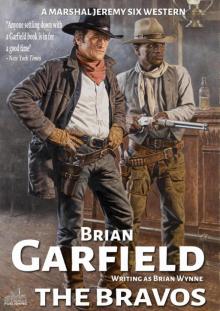 Marshal Jeremy Six #3
Marshal Jeremy Six #3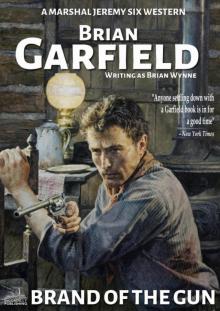 Marshal Jeremy Six #6
Marshal Jeremy Six #6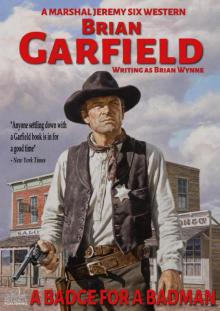 Marshal Jeremy Six #5
Marshal Jeremy Six #5 The Outlaws 2
The Outlaws 2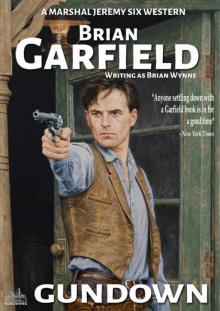 Marshal Jeremy Six #7
Marshal Jeremy Six #7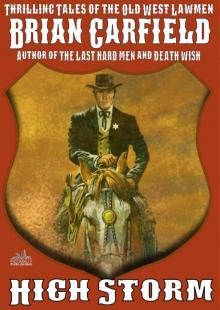 The Lawbringers 4
The Lawbringers 4 Marshal Jeremy Six #4 the Proud Riders
Marshal Jeremy Six #4 the Proud Riders The Romanov succession
The Romanov succession Marshal Jeremy Six #8
Marshal Jeremy Six #8 Sliphammer
Sliphammer Line of Succession
Line of Succession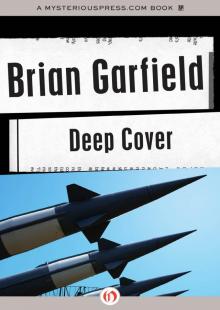 Deep Cover
Deep Cover Kolchak's Gold
Kolchak's Gold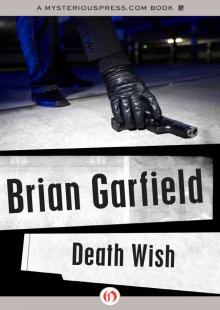 Death Wish
Death Wish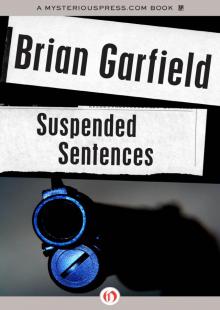 Suspended Sentences
Suspended Sentences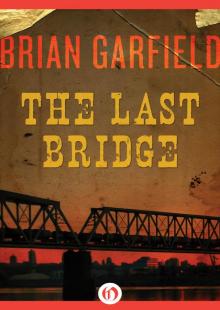 The Last Bridge
The Last Bridge Relentless
Relentless The Vanquished
The Vanquished The Last Hard Men
The Last Hard Men Hit and The Marksman
Hit and The Marksman Villiers Touch
Villiers Touch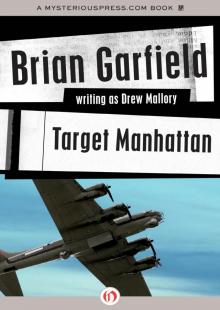 Target Manhattan
Target Manhattan Marchand Woman
Marchand Woman What of Terry Conniston?
What of Terry Conniston? Threepersons Hunt
Threepersons Hunt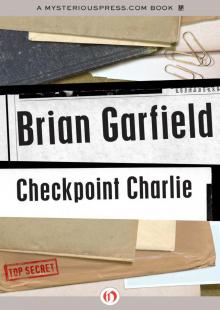 Checkpoint Charlie
Checkpoint Charlie Romanov Succession
Romanov Succession Necessity
Necessity Death Sentence
Death Sentence Fear in a Handful of Dust
Fear in a Handful of Dust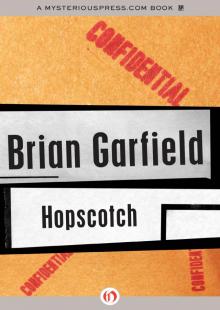 Hopscotch
Hopscotch